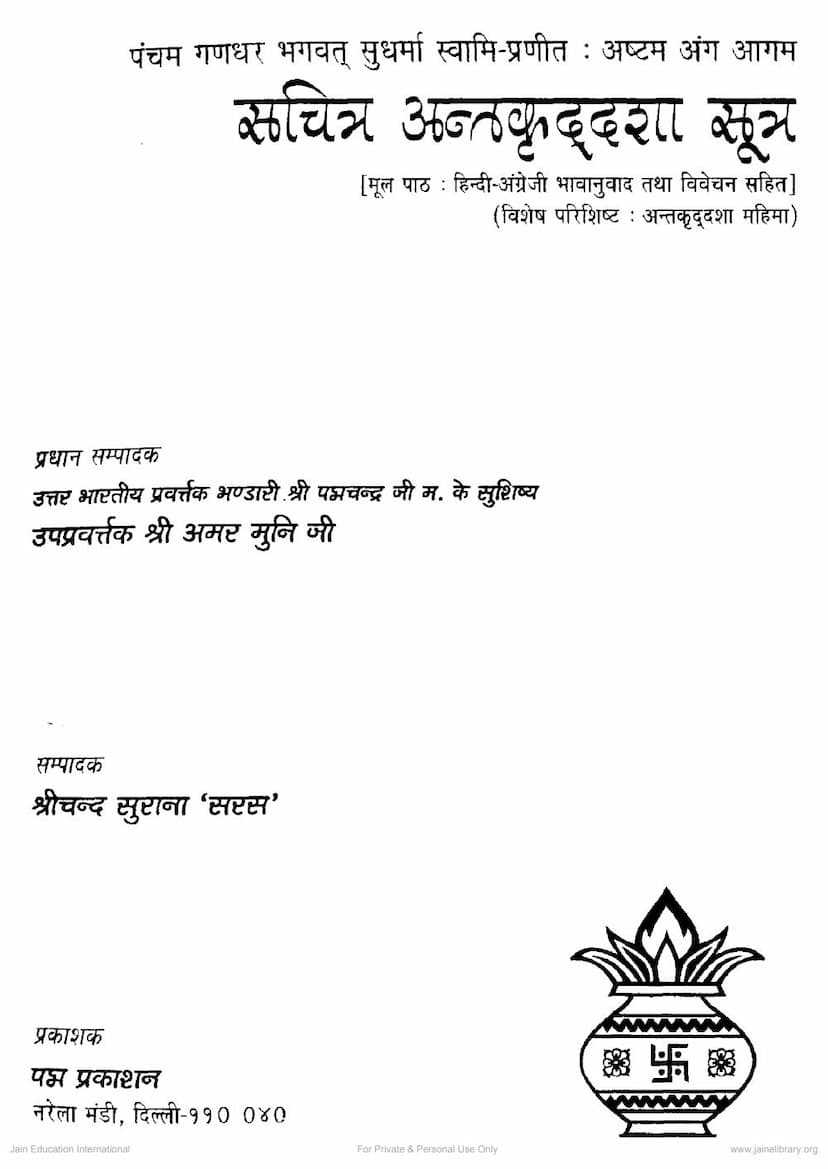Agam 08 Ang 08 Antkrutdashang Sutra Sthanakvasi
Added to library: September 1, 2025

Summary
Summary of Antakriddasha Sutra (Agam 08, Ang 08)
Title: Antakriddasha Sutra (The Sutra of those who have attained the end of the cycle of rebirth) Authors: Amarmuni, Shreechand Surana, Rajkumar Jain, Purushottamsingh Sardar Publisher: Padma Prakashan Catalog Link: https://jainqq.org/explore/007648/1
This Jain text, Antakriddasha Sutra, is the eighth Anga of the Agam literature, compiled by the fifth Ganadhar, Bhagavat Sudharma Swami. It details the lives and spiritual practices of 90 Jain ascetics (both male and female) who, through rigorous austerities, knowledge, right faith, and conduct, attained liberation (Nirvana) in their very lifetime, thereby ending the cycle of birth and death. Hence, they are called 'Antakrits' – those who have achieved the end.
The book is presented as a dialogue between Arya Jambu and Ganadhar Sudharma Swami, where Jambu seeks clarification from Sudharma about the teachings of Bhagavan Mahavir on the eighth Anga.
Key Aspects of the Sutra and the Book:
- Structure: The sutra is divided into eight sections (Vargas), containing a total of 90 chapters (Adhyayanas).
- Sections 1-5: Focus on 51 ascetics who lived during the time of Bhagavan Arishtanemi. These include the royal family members of Vasudeva Shrikrishna, such as princes and queens.
- Sections 6-8: Detail the lives of 39 ascetics from the era of Bhagavan Mahavir, who also achieved liberation in their lifetime.
- Content and Themes:
- The Goal of Liberation (Nirvana): The central theme is the attainment of liberation from the cycle of birth and death through rigorous spiritual practices.
- Austerities (Tapas): The sutra elaborates on various forms of austerities, highlighting their procedures, objectives, and benefits. It categorizes austerities into Outer (Anshan, Unodari, Bhiksha-charya, Ras-Parityag, Kayaklesh, Pratisamleenata) and Inner (Prayashchit, Vinaya, Vaiyavratya, Svadhyaya, Dhyan, Vyutsarga) types. It also details specific and complex penances like Gunaratnasamvatsar, Ratnavali, Kanakavali, Laghu-Mahasinghanishkridit, Muktavali, and Ayambil Vardhaman, showcasing the immense dedication of the ascetics.
- The Ideal of Renunciation: The text emphasizes the importance of detachment from worldly pleasures, family ties, and even the physical body to pursue spiritual goals.
- Illustrative Lives: The core of the sutra is the biographical accounts of 90 ascetics, demonstrating diverse paths to liberation. These include:
- Gautam Kumar: Practicing 12 Bhikshu Pratimas and Gunaratnasamvatsar Tap.
- Anikasena Kumar: Practicing 11 Angas, 14 Purvas, and a month-long Sanlekhana.
- Arjunamali: Enduring immense suffering with patience and achieving liberation through extreme forgiveness and penance.
- Dwaraka's Royal Family: The stories of queens like Padmavati, Gauri, Gandhari, Satyabhama, Rukmini, and others, who renounced their luxurious lives for spiritual pursuit.
- The Six Brothers: Disciples of Bhagavan Arishtanemi who practiced rigorous austerities.
- Sudarshan Sresthi: A merchant who demonstrated unwavering faith and steadfastness against extreme challenges.
- Megh Kumar and Atimukta Kumar: Royal princes who renounced worldly life for spiritual pursuit.
- The Queens of King Shrenik: Thirteen queens, including Nanda, Kali, Sukali, Mahakali, and others, who embraced asceticism and achieved liberation through various intense penances.
- The Yādava Clan: Various members of the Yādava clan, including princes and queens, who achieved liberation.
- Historical Context: The sutra provides insights into the socio-political and religious landscape of ancient India, mentioning cities like Champa, Dwaraka, Rajagriha, Kakandi, and Polaspur, and their significance. It also references prominent figures like King Shrenik, King Konik, Vasudeva Shrikrishna, Bhagavan Arishtanemi, and Bhagavan Mahavir, highlighting their interactions and influence.
- The Concept of Antakriya: The text delves into the concept of 'Antakriya,' which in Jain philosophy refers not merely to the physical rites after death but to the ultimate termination of karmic bondage and the attainment of liberation. It also discusses four types of Antakriya based on the intensity of karma and the duration of spiritual practice.
- Nidan (Volition): The sutra also touches upon the concept of 'Nidan' – strong desires or volitions formed during spiritual practice, which can lead to favorable rebirths but may also impede ultimate liberation if rooted in attachment or aversion.
- Pratima Yoga: The text details the 12 Bhikshu Pratimas, rigorous vows of ascetic conduct, and other specific practices like Sapta-Saptamika, Ashta-Ashtamika, Nav-Navamika, Dash-Dashamika, and various forms of Sarvatobhadra and Ayambil practices adopted by the ascetics.
- Language and Style: The sutra is composed in Ardha-Magadhi Prakrit, the language favored by Tirthankaras, Ganadhars, and celestial beings. The style is predominantly question-and-answer, making complex philosophical concepts accessible. The narrative is enriched with vivid descriptions of cities, palaces, gardens, and the spiritual journeys of the ascetics.
- Illustrations: The book features numerous colorful illustrations that visually represent the key events and characters described in the sutra, enhancing understanding and engagement for the reader.
- Publisher's and Editor's Vision: The publication is presented as a significant contribution to Jain Agamic literature, aiming to popularize the study and understanding of Jain scriptures through illustrated editions. It is published on the occasion of the Diksha Centenary of Acharya Samrat Pujya Shri Atmarama ji M.
In essence, the Antakriddasha Sutra is a profound text that illustrates the Jain path to liberation through the inspiring lives of ascetics who achieved the ultimate goal through unwavering dedication to spiritual practices, austerities, and self-purification. The book makes this ancient wisdom accessible and engaging through its comprehensive presentation and illustrative artwork.